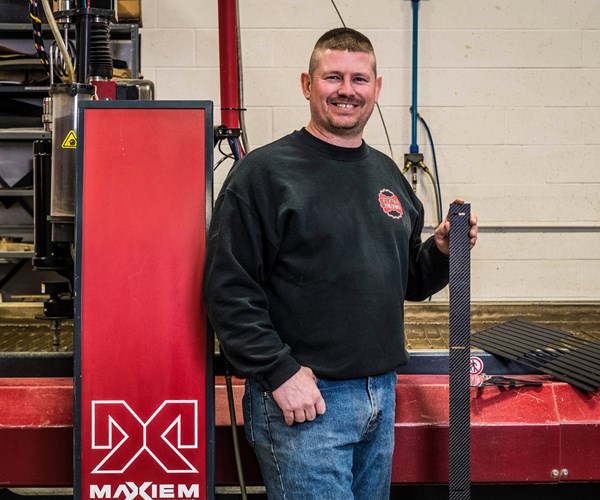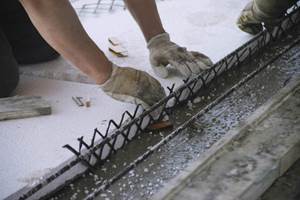OMAX waterjet brings success to one-man machine shop
RPM has been waterjet cutting a lot of composites, to the point that the company has gained a reputation as a composite cutting specialist.
Share

RPM Design (Brownsburg, IN, US) uses this OMAX waterjet cutter in its successful composites machining business.
The composites industry has embraced waterjet machining, thanks to its relatively low operating cost, fast cutting speed, fast set-up time and “cool” temperature, that is, the process does not create heat in the material or part being cut and is unaffected by the heterogeneity of composite materials. The use of jets or streams of water to cut materials goes back hundreds of years, but the concept of adding abrasives to water for cutting harder materials took off in the 1960s and early 1970s, with several companies contributing to the technology, developing pumps, nozzles, intensifiers and especially hardened orifices that could withstand the erosive action of the high-velocity abrasive grit. Waterjet precision has increased as well, as manufacturers have improved flow control. The number of companies that make and sell commercial waterjet machines is extensive; check out CW’s online SourceBook for a fairly complete list: https://www.compositesworld.com/suppliers/product/362.
One of these is OMAX Corp. (Kent, WA, US), which offers a wide range of abrasive waterjet machines, pumps and accessories. RPM Design (Brownsburg, IN, US) is an OMAX customer. RPM’s president Richie Price started the shop after 22 years as a CNC machinist. The shop cuts felt, wood, cardboard, plastic, phenolic plastic, fiberboard, fiberglass, brass, copper, steel, aluminum, stainless, Inconel and even bulletproof glass, all with one OMAX abrasive waterjet machine, a MAXIEM 1530 JetMachining Center, according to a case study provided to CW by dgs Marketing Engineers (Fishers, IN, US). More recently, RPM has been waterjet cutting a lot of composites, to the point that Price’s company has gained a reputation as a composite cutting specialist.
According to the dgs Marketing Engineers case study, cutting composites wasn’t in Price’s original business plan, but the material’s high strength and light weight have made it a necessity in racing, aerospace and other applications; the shop’s customers have included likes of IndyCar teams and NASCAR competitors, as well as top drag racers Don Schumacher and John Force.
“There are no worn cutters or resulting frayed part edges to deal with when cutting carbon fiber with a waterjet instead of a conventional machine,” says Price. “Consumables costs are also much lower with waterjets.” In fact, the tooling cost for waterjets, according to Price, is basically the same no matter what material is being cut.
When exploring the prospects for a dedicated waterjet job shop, Price talked with his colleagues in manufacturing and racing to secure waterjet work while consulting with manufacturers of waterjet machines. He was impressed by the comprehensive response from OMAX and ultimately decided to purchase the MAXIEM 1530 JetMachining Center. It features a bridge-type linear motion system with a 3.1m x 1.54m X-Y cutting area. Price recently added a software-controlled A-Jet multi-axis cutting head. The machine’s programmable motorized Z-axis with 30 cm of travel permits machining of single sheets or stacks of workpieces up to nearly a foot thick. Linear encoders provide 1-micron resolution feedback to the motor control system.

Richie Price of RPM Design, and the OMAX Maxiem waterjet machine.
Price says setting up a waterjet is not difficult: “I think it’s easier to fixture a part on a waterjet than it is on a CNC machine.” The shop often employs nesting strategies for cutting multiple parts on a single sheet or plate of material, maximizing material utilization and minimizing setup time for different parts. About 80% of the shop’s work involves nesting, and Price claims it is an easy process to learn, thanks to training provided by OMAX: “They are very thorough. Having the machinist background that I had, it wasn’t a big hurdle for me to overcome. We set the machine up and the guy spent a couple of days here. In a few hours we were off and running, cutting parts,” he asserts.
The A-Jet multi-axis cutting head, which Price has added to his MAXIEM, provides an angle-cutting range from 0° to 60° and facilitates the machining of beveled edges, angled sides and countersinks. Intelli-MAX Software from OMAX even enables the A-Jet head to compensate for the natural taper of a water jet stream (more on that below) to create complex 3D shapes. It also offers high positioning accuracy so that parts can be cut without secondary finishing to significantly reduce part production time. The head is calibrated within 0.0015”, which allows Price to cut complex parts like vehicle exhaust header flanges. “I still do parts, including those made from composites, for Indy cars, and two years ago parts that I produced here were on the pole-sitting car for the Indy 500,” reveals Price. Over his career he has made parts for winning vehicles in nearly every form of motor sports but having waterjet-machined parts from his own shop on the Indy pole sitter was especially satisfying.
The RPM Design shop schedule is generally booked about a week or a week and half in advance. “Depending on the run time of a job and the scheduling, the day I start on a job it usually is done,” Price notes. Price said balancing the shop’s work schedule is his biggest challenge, because RPM Design is currently a one-man show. Fortunately, the accuracy and reliability of the MAXIEM machine enables continuous, uninterrupted operation. “I put a large piece of material in the machine at the end of the day and when I come in the next morning, it’s done,” he adds. He handles work orders that include assemblies for material handling, medical, automotive, aerospace and heavy equipment as well as racing, and also offers manufacturing consulting for prospective customers. For example, while lasers sometimes offer better pricing on thinner materials depending on the product and any required secondary operations, waterjet is the more efficient and economical choice in most situations. Price said his machine can cut essentially anything, but “I try to steer people in the direction that will help them most.”
For a detailed look at the advantages and possible limitations of waterjet cutting, visit Boulder Engineering Studio’s (Boulder, CO, US) look at the technology here: https://www.boulderes.com/resource-library/pros-and-cons-of-waterjet-cutting. It includes interesting information about, for example, the tapers that result from waterjet, and how those can be addressed. Visit CW’s archives for stories on machining composites, including this one: https://www.compositesworld.com/articles/machining-carbon-composites-risky-business.
Related Content
Composites-reinforced concrete for sustainable data center construction
Metromont’s C-GRID-reinforced insulated precast concrete’s high strength, durability, light weight and ease of installation improve data center performance, construction time and sustainability.
Read MoreCCG FRP panels rehabilitate historic Northamption Street Bridge
High-strength, composite molded, prefabricated panels solve weight problems for the heavily-trafficked bridge, providing cantilever sidewalks for wider shared use paths.
Read MoreComposites reinvent infrastructure
Celebrating National Composites Week, CW shares ways in which composites continue to evolve the way we approach infrastructure projects.
Read MoreCCG meets customer demand with StormStrong utility pole lineup
Additional diameters build on the portfolio of resilient FRP pole structures for distribution and light pole customers.
Read MoreRead Next
All-recycled, needle-punched nonwoven CFRP slashes carbon footprint of Formula 2 seat
Dallara and Tenowo collaborate to produce a race-ready Formula 2 seat using recycled carbon fiber, reducing CO2 emissions by 97.5% compared to virgin materials.
Read MorePlant tour: Daher Shap’in TechCenter and composites production plant, Saint-Aignan-de-Grandlieu, France
Co-located R&D and production advance OOA thermosets, thermoplastics, welding, recycling and digital technologies for faster processing and certification of lighter, more sustainable composites.
Read MoreVIDEO: High-volume processing for fiberglass components
Cannon Ergos, a company specializing in high-ton presses and equipment for composites fabrication and plastics processing, displayed automotive and industrial components at CAMX 2024.
Read More






















